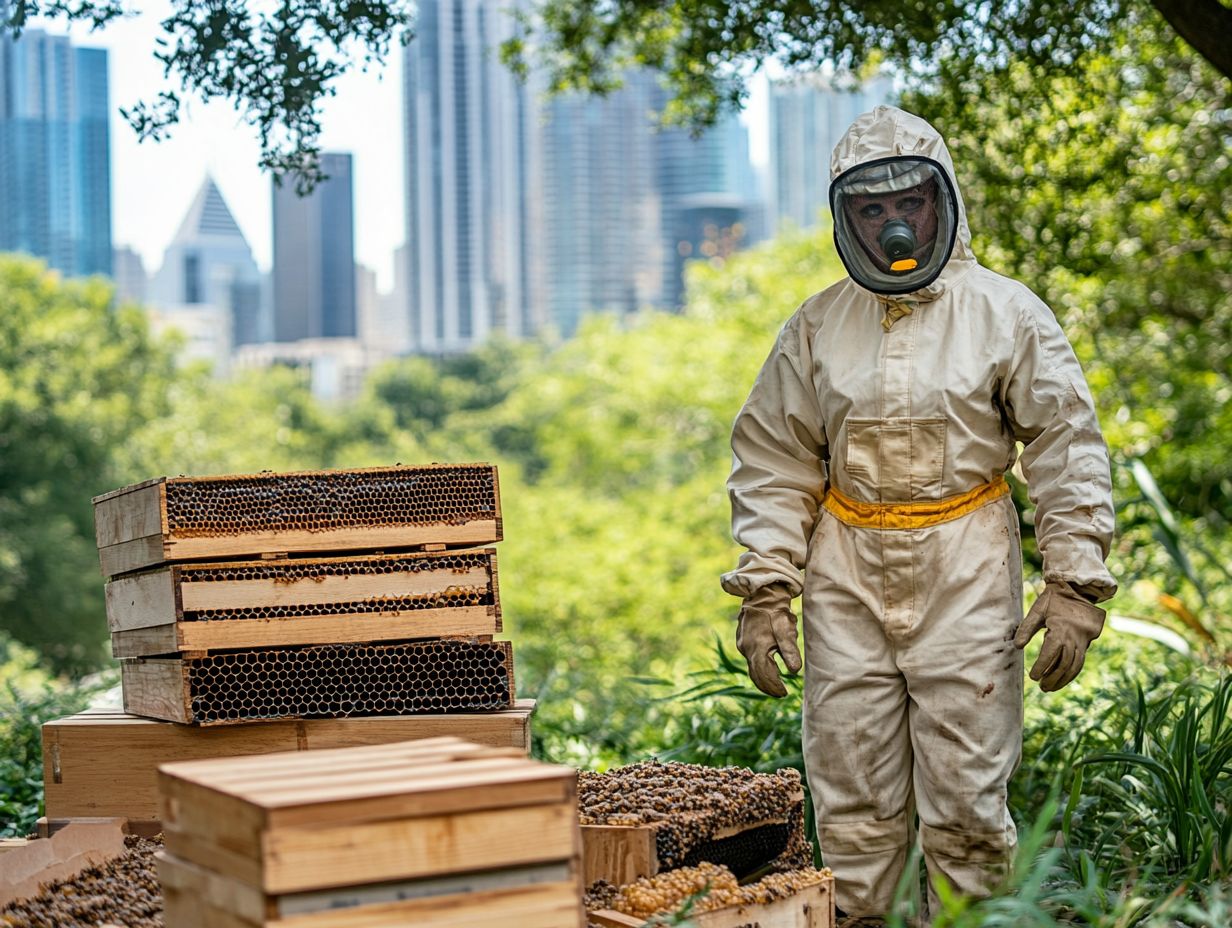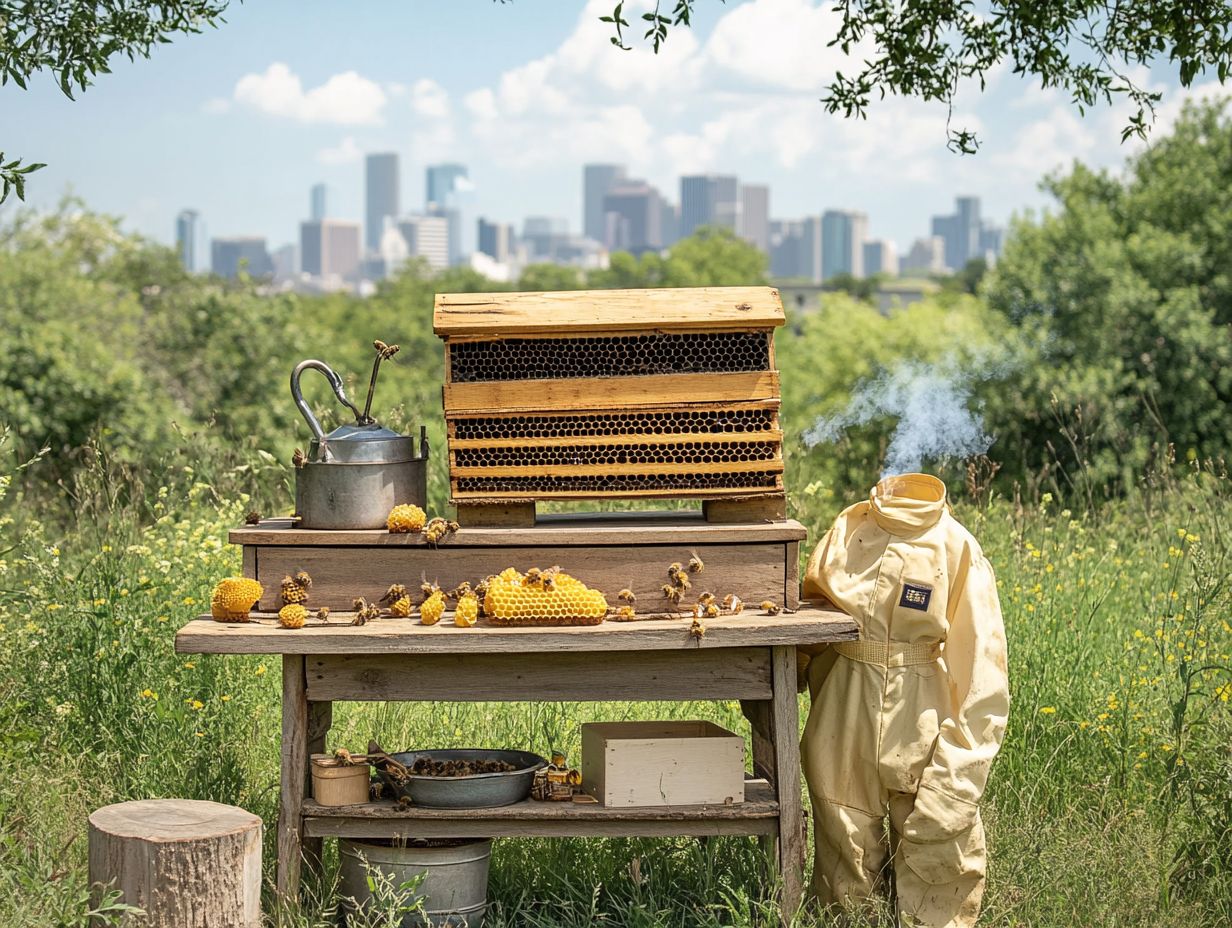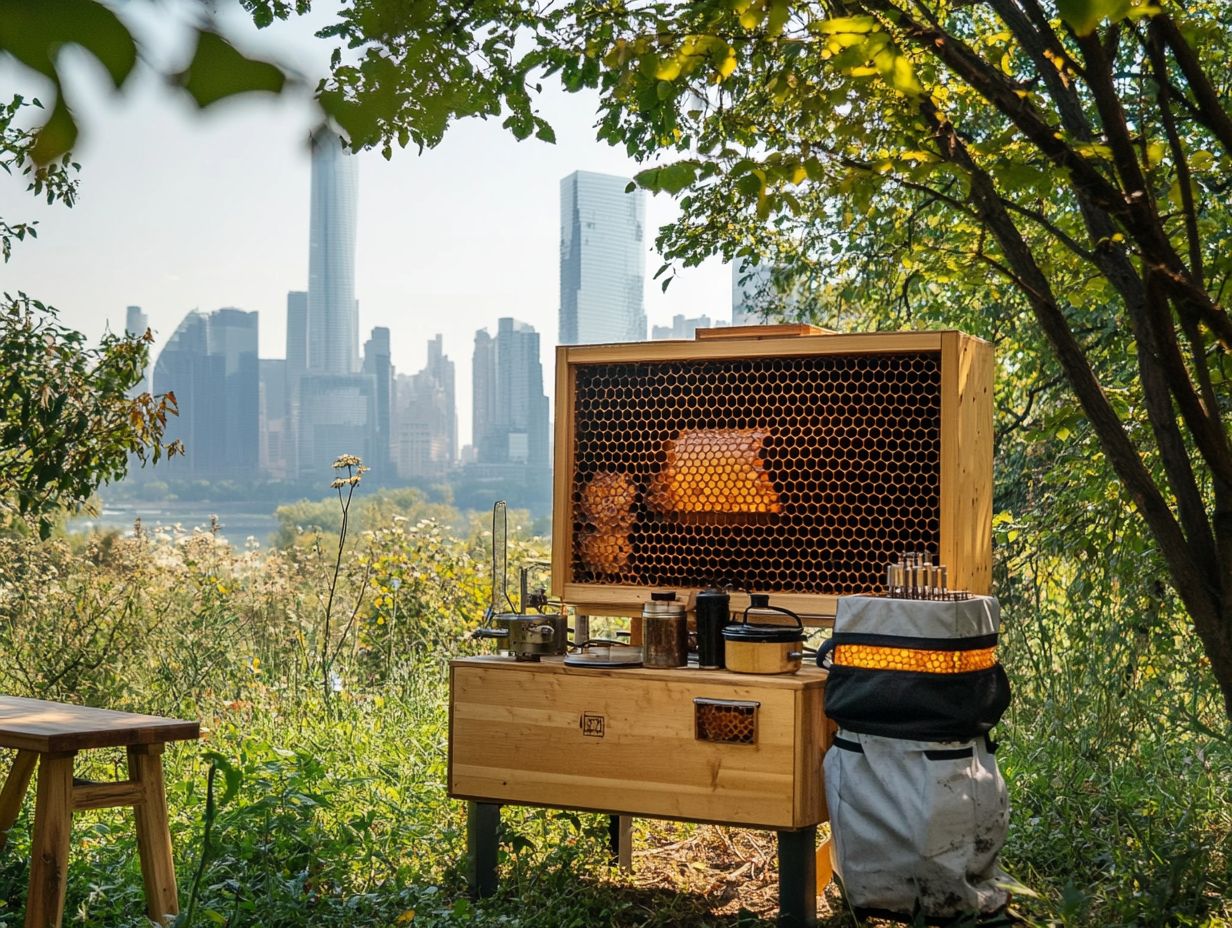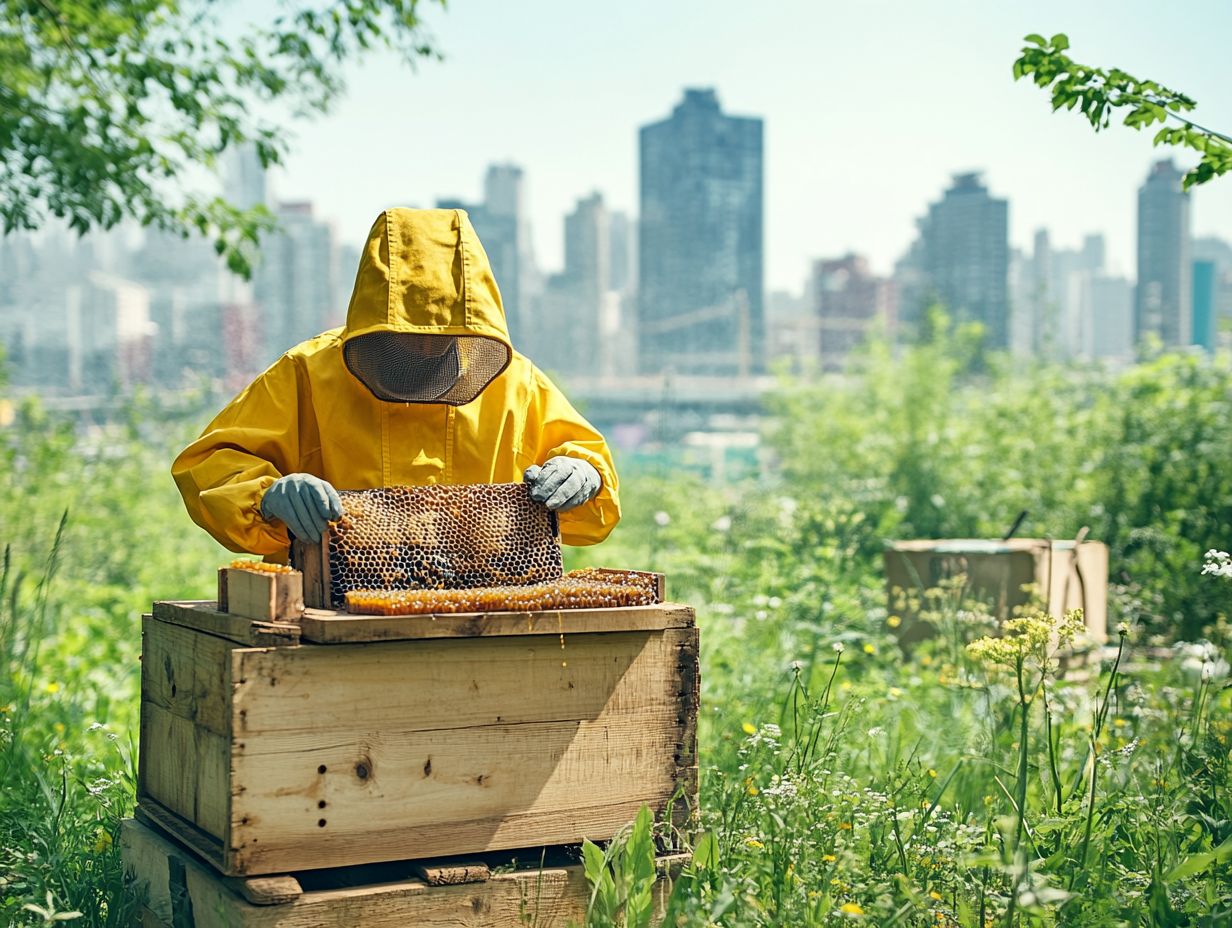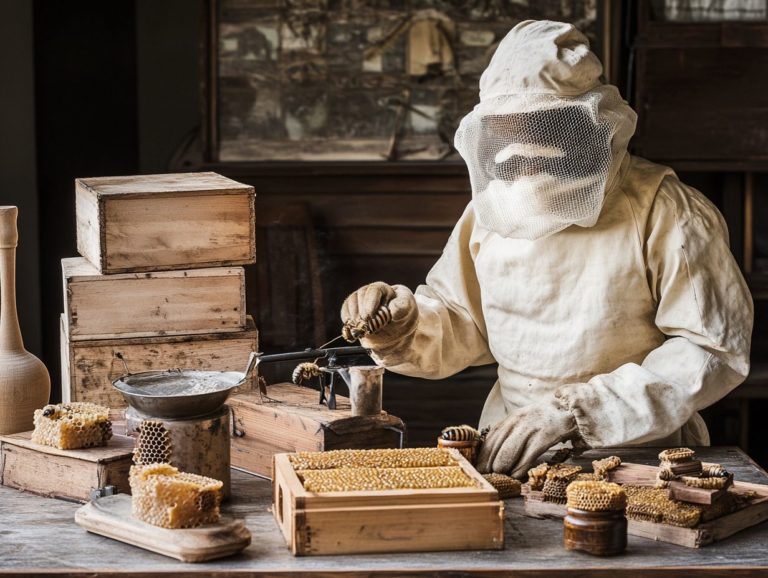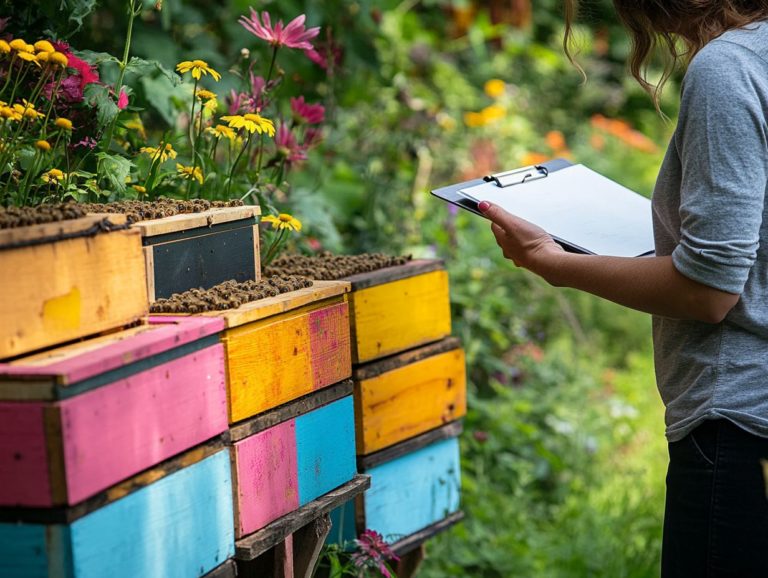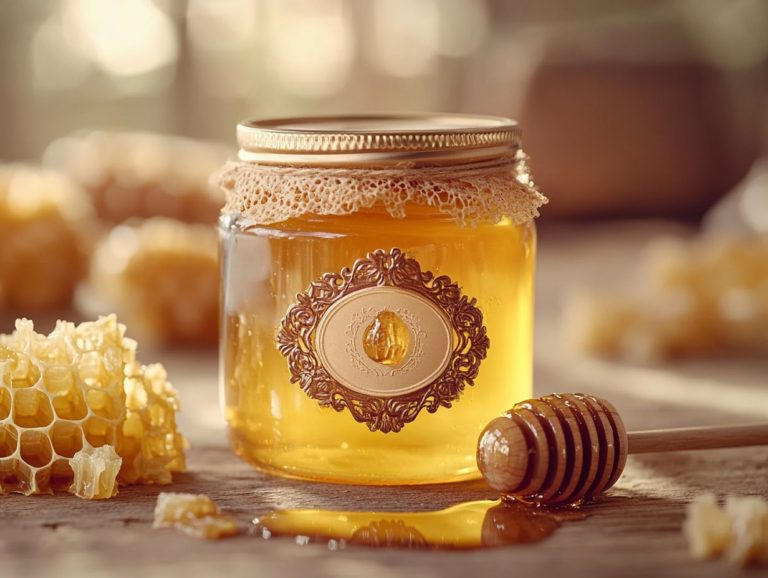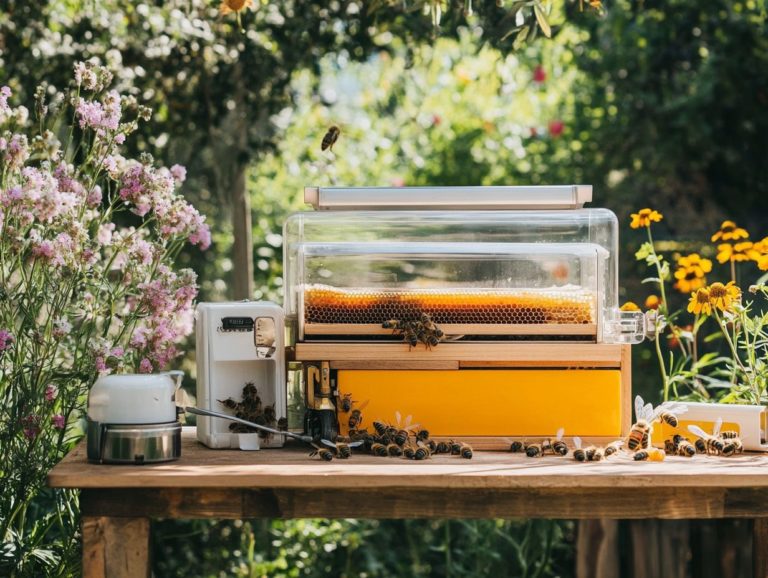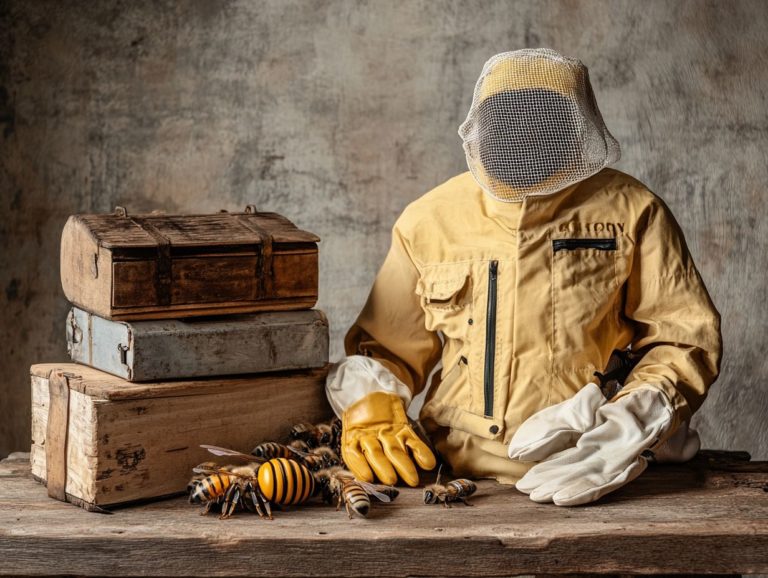Best Beekeeping Equipment for Urban Areas
Urban beekeeping is on the rise, beautifully intertwining the sweet craft of honey production with the vibrant energy of city life.
In a setting where space is limited and challenges are unique, having the right equipment is essential for ensuring both your bees and your neighbors flourish.
This article delves into the best beekeeping tools specifically designed for urban environments, highlights the benefits of keeping bees in the city, and offers practical tips for fostering positive relationships with your local community and ecosystem.
Whether you’re an experienced beekeeper or just embarking on this journey, this guide gives you everything you need to succeed in the world of beekeeping!
Contents
- Key Takeaways:
- 1. Hive Set-Up for Limited Space
- 2. Protective Gear for Urban Beekeeping
- 3. Smoker for Calming Bees
- 4. Honey Extractor for Harvesting Honey
- 5. Bee Brush for Gentle Handling
- 6. Queen Excluder for Controlling Hive Population
- 7. Feeder for Supplemental Feeding
- 8. Swarm Catcher for Relocating Bees
- 9. Hive Tool for Manipulating Hive Components
- 10. Beekeeping Suit for Full Body Protection
- How Can Urban Beekeepers Overcome Space Limitations?
- Frequently Asked Questions
- What is the best type of hive for urban beekeeping?
- What protective gear is necessary for urban beekeeping?
- Can I keep bees in my backyard in an urban area?
- What type of smoker should I use for urban beekeeping?
- What is the best method for harvesting honey in an urban area?
- How can I protect my beehives from pests in an urban area?
Key Takeaways:
- Select a hive that fits your urban space perfectly.
- Invest in protective gear, like a bee suit and gloves, to ensure safe and comfortable beekeeping.
- Use a smoker to calm bees and make hive inspections and maintenance easier.
1. Hive Set-Up for Limited Space
Setting up a hive for home beekeeping can be both rewarding and challenging, particularly when you’re working with limited space in backyards or small gardens in Culleoka, Tennessee. Consider techniques like tall hives or wide hives that maximize your available area while keeping conditions optimal for your honey bees, the heart of your urban beekeeping effort, all in line with sustainable beekeeping practices.
In urban settings, you’ll encounter unique considerations—like finding the perfect apiary location that captures sunlight while shielding your hives from harsh winds. Local apiary laws will also dictate where you can place your hives and how many you’re allowed to have per property, making it essential for you to familiarize yourself with these regulations.
Ensuring adequate space within the hives is crucial for your bees’ comfort and productivity. Adopting effective hive management, particularly hive inspection practices, will allow you to monitor their health throughout the seasons.
Adam Martin from Bee Kept shares exceptional insights and methodologies that empower both novice and seasoned beekeepers, helping them navigate these challenges and ensuring that urban beekeeping thrives even in compact environments.
2. Protective Gear for Urban Beekeeping
Protective gear ensures both safety and comfort while managing your colonies, especially in the vibrant hustle of city life where encounters with feral bees or aggressive hives can happen unexpectedly.
The range of protective equipment at your disposal includes beekeeping suits, gloves, veils, and boots, all meticulously designed to provide layers of defense against potential stings. A well-fitted beekeeping suit acts as a protective barrier, reducing the likelihood of panic-driven reactions that could provoke swarming or defensive behavior from your hives.
By wearing the appropriate gear, you not only safeguard yourself but also foster a calmer environment for the bees, promoting their overall health and well-being. This approach aids in effective pest management, including natural methods, as minimizing stress on the bees can bolster their resilience against diseases and pests, ultimately contributing to the stability of the urban ecosystem you’re a part of.
3. Smoker for Calming Bees
A smoker is an essential tool in your beekeeping arsenal, playing a pivotal role in soothing bees during hive inspections. This allows for a safer and more effective management of your colonies.
When lit, the smoker generates cool smoke that cleverly masks the alarm pheromones released by bees, reducing their defensive behaviors. To achieve this calming effect, you can utilize various natural materials as fuel, such as dried grass, pine needles, or even specialized smoker pellets. It’s crucial to stick to natural options to ensure the safety of both the bees and the honey.
Timing is everything when it comes to using the smoker. You should light it up before approaching the hive and deliver gentle puffs of smoke at the entrance and throughout the frames during inspections. This approach guarantees a smoother interaction, keeping bee activity relaxed and allowing you to perform a thorough check with ease. Using a smoker can make your inspections calmer and even enjoyable!
4. Honey Extractor for Harvesting Honey
A honey extractor is an essential tool for you as a beekeeper. It helps you harvest honey efficiently while ensuring quality without harming the honeycomb. This maximizes production and ensures you deliver a top-notch product.
You have two primary options when it comes to extractors: manual and electric. Manual extractors, with their hand-cranked mechanisms, are perfect for hobbyists or small-scale operations. They offer elegant simplicity and tend to be more budget-friendly. Electric extractors, on the other hand, are designed for speed, making them ideal for larger beekeeping ventures. They save you precious time during busy harvest seasons.
Each type also comes with a variety of accessories, such as uncapping knives (tools used to remove the wax caps from honey cells), strainers, and buckets, which are invaluable for the extraction and bottling processes.
Using proper extraction techniques is vital for maintaining the integrity of the honeycomb and ensuring your bees remain healthy. This attention to detail will help you achieve high-quality honey, free from any contaminants, elevating your beekeeping experience.
5. Bee Brush for Gentle Handling
Using a bee brush is an elegant approach to managing your hives. It allows you to gently guide bees away from frames without causing harm. This tool becomes invaluable during inspections, where you need to carefully check the hive’s health, and during honey harvesting, where minimizing disturbance to the bees is crucial.
By sweeping the bees lightly, you create a calmer atmosphere, significantly reducing stress on the colony. Using gentle techniques is crucial for keeping bees healthy and encourages them to continue their essential roles within the ecosystem.
Proper handling fosters a sense of trust between you and your bees, nurturing a harmonious relationship that benefits everyone involved.
6. Queen Excluder for Controlling Hive Population
A queen catcher is a critical tool in your beekeeping arsenal. It is expertly designed to manage hive population by allowing worker bees to come and go while keeping the queen safely contained. It optimizes honey production and promotes healthier hives by preventing overcrowding, which can lead to stress and disease.
To install a queen excluder, simply place it horizontally above the brood box. Ensure the bars are aligned correctly to facilitate easy passage for the worker bees. Regular maintenance is key; be sure to inspect the excluder periodically for any blockages or distortions that could hinder the bees’ flow. By thoughtfully managing the queen’s space, you safeguard the hive’s overall health, creating a thriving environment that benefits both your bees and your beekeeping endeavors.
7. Feeder for Supplemental Feeding
A feeder is a critical tool for urban beekeepers looking to provide supplemental feeding to honey bees, particularly during times of low nectar availability. This support helps maintain a healthy diet for your bees.
By choosing the right type of feeder—like frame feeders or entrance feeders—you can ensure your colonies receive the necessary nutrients when resources are scarce. Frame feeders fit snugly inside the hive, helping retain warmth and making monitoring easy. Entrance feeders offer convenient access for a quick refresh.
Timing is everything; feeding your bees in late winter or early spring can rejuvenate colonies and enhance their resilience. Don’t let your bees go hungry—utilizing methods like sugar syrup or pollen patties during these vital periods not only promotes hive health but also encourages active foraging behaviors in the bees, ultimately contributing to a thriving ecosystem.
8. Swarm Catcher for Relocating Bees
A swarm catcher is an essential tool for you as a beekeeper. It allows for the safe relocation of swarms, which is especially crucial in urban environments where feral bees may establish colonies unexpectedly.
To utilize a swarm catcher effectively, you should adopt a strategic approach. Begin by familiarizing yourself with the signs of a swarm, such as clusters of bees or buzzing activity in nearby trees or buildings. Once you’ve identified a swarm, gently coax the bees into the catcher using natural scents that attract bees or other attractants.
The beekeeping community plays a vital role in swarm management. They offer workshops and resources that educate both new and seasoned beekeepers on best practices. By sharing experiences and providing guidance, you not only strengthen the community but also promote responsible beekeeping in urban settings, ensuring that both bees and humans coexist in harmony.
9. Hive Tool for Manipulating Hive Components
A hive tool is a critical piece of beekeeping equipment that gives you the power to manipulate hive components, ensuring effective management and seamless access to frames.
These tools come in various types, each designed to elevate your beekeeping experience. For example, a rigid hive tool proves invaluable when prying apart frame walls or lifting heavy components. A smoker tool plays a crucial role in calming bees during inspections. A frame grip simplifies the handling of frames, allowing for smoother extraction and replacement.
Familiarizing yourself with each tool’s unique function is essential for any beekeeper determined to maintain thriving hives.
10. Beekeeping Suit for Full Body Protection
A beekeeping suit offers you comprehensive protection as an urban beekeeper. It ensures your safety while enabling effective hive management, particularly when you encounter potentially aggressive bees.
These suits are crafted from premium materials that withstand the demands of beekeeping, all while prioritizing your comfort and functionality. With strategically placed mesh panels, the suit allows for optimal airflow during warmer days, keeping you cool and preventing any risk of overheating.
Wearing the right protective gear is vital for your safety! It not only safeguards you from stings but also helps maintain the health of your bees by minimizing disturbances during hive inspections. Embracing safe practices fosters a harmonious environment for urban beekeeping, ultimately benefiting both the bees and the local ecosystem.
How Can Urban Beekeepers Overcome Space Limitations?
Urban beekeepers often encounter challenges related to limited space. However, you must tackle these obstacles head-on to keep your colonies thriving!
Implementing vertical hives presents a clever solution. This approach allows you to maximize restricted ground space while promoting healthy airflow and sunlight exposure. It is particularly beneficial in densely populated areas where horizontal hives are at a premium.
Selecting strategic locations for your apiaries—such as rooftops or community gardens—optimizes the bees’ foraging routes and encourages collaboration with local residents.
By integrating sustainable beekeeping practices, such as using organic treatments and planting pollinator-friendly flora, you can enhance urban environments. This fosters a harmonious setting that supports both bee health and community engagement.
What Are the Benefits of Keeping Bees in Urban Areas?
Keeping bees in urban areas offers a wealth of benefits. It boosts honey production, enhances bee health, and fosters greater community involvement in sustainable practices. Integrating educational programs about beekeeping can make a significant impact.
Urban beekeeping also helps pollinate local gardens, parks, and the diverse flora that thrive in cityscapes. This contributes to healthier ecosystems overall. As cities embrace this green initiative, local residents become more aware of the significance of bees and biodiversity. This awareness can spark a ripple effect of environmental consciousness.
Look at the success stories—cities like New York and London have revitalization projects where community gardens bloom alongside beekeeping efforts. This promotes ecological balance and nurtures camaraderie among neighbors. These initiatives support pollinator populations and cultivate a deeper appreciation for nature.
What Are the Challenges of Urban Beekeeping?
Urban beekeepers encounter various challenges. Navigating local apiary laws, managing pests, and ensuring the well-being of bees in bustling city environments can be complex.
These hurdles can feel overwhelming, especially given the limited access to resources that traditional beekeepers may take for granted. Knowing your local beekeeping laws is vital to avoid fines and keep your hives safe. You may encounter unique pest challenges due to the close proximity of different habitats that attract unwanted insects.
Crafting a comprehensive pest management plan that combines natural and chemical solutions while adhering to municipal regulations can significantly boost your chances of maintaining a thriving bee population. Building relationships with local agricultural extension offices and fellow beekeepers allows you to exchange effective strategies and experiences. This includes discussing honey harvesting techniques to navigate the challenges of urban beekeeping with greater ease.
How Can Urban Beekeepers Ensure the Safety of Their Neighbors?
Ensuring the safety of your neighbors is a top priority as an urban beekeeper. Implementing effective bee management practices, including tools like a bee brush, can ease concerns about hive behavior.
Place your hives away from high-traffic areas and secure them against potential disturbances. This reduces the chance of unwanted encounters.
Open communication with your neighbors is essential. Sharing insights about the benefits of bees and explaining safe interaction methods fosters trust and understanding.
Scheduling regular hive inspections and quickly addressing any issues showcases responsible management, creating a supportive sense of community.
Involving your neighbors in educational events, like honey tastings or hive tours, can further solidify these relationships and enhance their appreciation for the vital role bees play in our ecosystem.
What Are the Best Practices for Urban Beekeeping?
To keep your bees happy and healthy, it’s important to follow best practices for urban beekeeping. Using Langstroth frames—a commonly used hive design that allows for easy honey extraction—and Layens frames is crucial for maintaining healthy colonies and ensuring successful honey production.
Regular hive inspections and effective feeding strategies are key elements to prioritize. Routinely check your hives for signs of disease, pests, and overall health. Identify issues early and take corrective measures. Providing the right nourishment, especially during scarce foraging periods, enhances your bees’ vitality.
Engaging with the local beekeeping community is vital. Sharing experiences and knowledge fosters collaboration, enabling you to exchange valuable tips and resources. This supportive network sharpens your individual beekeeping skills and strengthens the collective effort in promoting sustainable practices that benefit both the bees and their urban habitats.
Join your local beekeeping group today and become part of this exciting movement!
How Can Urban Beekeepers Support the Local Environment?
Urban beekeepers have a remarkable opportunity to enhance the local environment by cultivating bee habitats, fostering biodiversity, and raising awareness about the critical role of pollinators.
Start your journey by planting vibrant, pollinator-friendly flowers in your garden, ensuring a consistent supply of nectar and pollen throughout the blooming season.
Engaging in local community events or workshops will allow you to highlight the significance of these tiny yet critical creatures, illustrating how everyone can actively participate in bee conservation efforts.
You can also collaborate with schools to create educational programs about the vital role bees play in food production and ecosystem health. This can inspire the next generation to appreciate and safeguard these essential pollinators, fostering awareness of the importance of bee habitats in our urban environment.
Frequently Asked Questions
-
What is the best type of hive for urban beekeeping?
The best hive for urban beekeeping is a top bar hive, a type of beehive that is easier to manage in small spaces compared to traditional Langstroth hives.
-
What protective gear is necessary for urban beekeeping?
A beekeeper suit and veil are essential for urban beekeeping. It is also recommended to wear gloves and closed-toe shoes for added protection.
-
Can I keep bees in my backyard in an urban area?
Yes, it is possible to keep bees in your backyard in an urban area. However, it is important to check with your local government for any restrictions or regulations on beekeeping in your specific area.
-
What type of smoker should I use for urban beekeeping?
A cold smoker is the best option for urban beekeeping as it produces less smoke and is less likely to disturb your neighbors.
-
What is the best method for harvesting honey in an urban area?
The best method for harvesting honey in an urban area is to use a fume board. This allows you to remove the honey without disturbing the bees, reducing the risk of stings.
-
How can I protect my beehives from pests in an urban area?
In addition to regular hive inspections, it is important to use entrance reducers and bee-proof screens to prevent pests from entering the hive. Keeping the area around the hive clean and free of standing water can also help deter pests. Act now to protect your beehives from pests!
Join the movement to protect our pollinators today!

